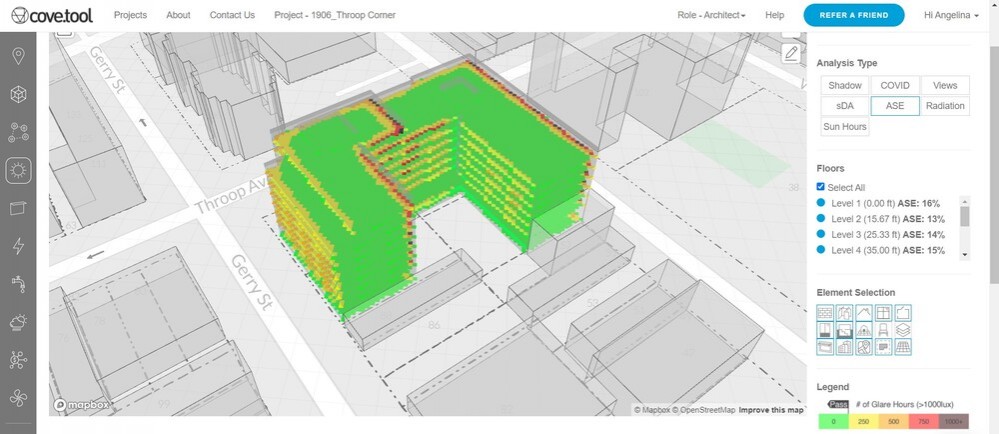What's it like to be a Marvel intern?
Angelina Li gives insight into the opportunities and experiences one can expect from an internship at Marvel.
Why did you choose to apply for an internship at Marvel?
Rensselaer Polytechnic Institute (RPI) has a co-op program built into our curriculum, so I was in search of an internship, which was challenging to find at the start of the pandemic. Around that time, I participated in an AIA women's mentorship program to get advice and feedback on my portfolio and resume. I was fortunate to match with Lissa [So], one of Marvel’s partners, at that event, and I told her I was looking for an internship. I presented my portfolio and resume, which showcased my experience with graphic design and layout work for the publications team at my school. She was able to connect me with the business development (BD) team, and I interviewed with them and was hired. I started my internship in March 2021, and worked full time from then until the end of August, when the fall semester started. I’m now working part-time, in between my classes.

What have you been able to do during your time at Marvel?
I started off working with the graphic design team, organizing graphic standards projects, project sheets, business cards, and resumes. With Pablo [Ceja] and Annya [Ramírez-Jiménez], I worked on subcontracting research and assembling quals, lookbooks, SF330 forms, and supported book production and interview preparation. This enabled me to gain a lot of exposure and experience with many different sides of Marvel and the industry in general.
I started off working with the graphic design team, organizing graphic standards projects, project sheets, business cards, and resumes. With Pablo [Ceja] and Annya [Ramírez-Jiménez], I worked on subcontracting research and assembling quals, lookbooks, SF330 forms, and supported book production and interview preparation. This enabled me to gain a lot of exposure and experience with many different sides of Marvel and the industry in general.
I produced zoning analysis studies, drawings, 3D models, and helped with conceptual design, working in Revit, Rhino, and various Adobe applications. I also was able to get firsthand experience sitting in on meetings and communicating directly with clients.
After the summer, I wanted to continue my internship experience, so I’ve been working in between classes. Lately I’ve been supporting awards submissions and have been doing some modeling for the sustainability group, using cove.tool to run energy simulations.
I really liked that I was able to touch upon so many different areas while interning at Marvel. At first, I thought going into an architecture firm that I’d be working on CAD drawings all day, but it was cool that I was able to gain a wide range of experience.
 The energy modeling software cove.tool is used to study the impact of sunlight on a project.
The energy modeling software cove.tool is used to study the impact of sunlight on a project.What did you learn from working with the business development team, and how will you apply that knowledge to your studio work in the future?
Working with the BD team opened the door to new directions within the architecture industry. This experience gave me a larger perspective of different architecture-related projects that I could be involved in, as I’m not closing myself off to any opportunities at this point in my career.
In the meantime, I want to focus on completing my AXP hours and passing the exams to get my architecture license. And, if I were to decide to get another degree, maybe an MBA or a Masters in urban design, but I am open to whatever life throws at me.
What are the differences you see with studying architecture and the actual studio practice of it?
I see more similarities between studying architecture and the actual studio practice of it than I do differences. In both instances, you are in a highly collaborative working environment, in constant communication with your team, pushing your design towards a higher resolution, and trying to meet deadlines. In school, your professors are essentially your clients; they give you constraints on your project and help guide your design.
The majority of the projects we do in school are abstract and conceptual, and never reach the level of realism that real life design must. Some academic projects are also never meant to be realistic, and you’re given unrestrained freedom to explore conceptually.
The main difference between school and actual practice is the obvious level of realism that exists in actual practice. You must follow zoning and coding regulations and you start looking into material specs, manufacturers, and begin making decisions based off budget and schedule. Your design will directly affect the community and peoples’ lives, and could drive larger scale changes in the city. There are more complex networks and implications your design will need to consider.
Another difference I was able to experience in the actual studio practice was collaborating with various consultants during meetings. In school, you might get to work with engineering students on certain projects, but in actual practice the team is significantly larger and there are many more roles involved.
What words of advice do you have for others beginning design internships?
What you get out of an internship really relies on what you’re able to put in. The more involved you are and the more you do, the more experience and exposure you’ll get. I would recommend for future interns to be ambitious, say yes a lot, and go after any opportunities that come up. If you have the bandwidth to work on many different things, it’ll only give you more experience to step into the profession once you graduate.
Marvel is still accepting applications for internships in our New York, San Juan, and Richmond offices! Head over to our careers page for more info.
